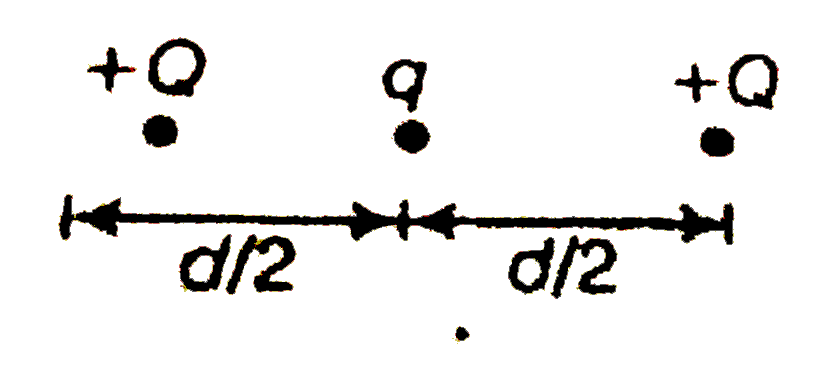Two equal charges, 2.0×10−7C each, are held fixed at a separation of 20cm. A third charge of equal magnitude is placed midway between the two both the charges. How much work is done by the electric field during the process?Solution in Tamil
When the charge is placed at a,
e1=72×10−4J
When charge is placed at b,
e2=36×10−4J
workdo≠=e1−e2
=(72−36)×10−4
36×10−4J=3.6×10−3J
Topper's Solved these Questions
- BOOK - HC VERMACHAPTER - ELECTRIC FIELD AND POTENTIALEXERCISE - Objective 28videos
ELECTRIC FIELD AND POTENTIAL
- BOOK - HC VERMACHAPTER - ELECTRIC CURRENT THROUGH GASESEXERCISE - Exercise23videos
ELECTRIC CURRENT THROUGH GASES
- BOOK - HC VERMACHAPTER - ELECTROMAGNETIC INDUCTIONEXERCISE - EXERCISE98videos
ELECTROMAGNETIC INDUCTION
Similar Questions
Mart out the correct options
04:38View SolutionA discharge tube contains helium at a low pressure. A large potential difference is applied across the tube. Consider a helium atom that has just been ionized due to the detachment of an atomic electron. Find the ratio of the distance travelled by the free electron to that by the positive ion in a short time dt after the ionization.
01:35View SolutionCalculate the dimensions of (a) ∫→E.d→l,(b)vBlanddΦ0dt. The symbols have their usual meanings.
03:48View SolutionTwo chargea 2.0xx10^(-6) C are placed at a separation of 10 cm. where should a third charge be placed such that it experiences no net force due to these charges.
02:38View SolutionAn electric charged q exerts a force F on a similar electric charge q swparated by a distance r. A third charge q/4 is placed midway between the two charges. Now the force F will
05:19View SolutionTwo positive point charges , each Q , are fixed at separation d . A third charge q is placed in the middle. Describe the equilibrium of the third charge.
02:30View SolutionTwo equal charges of magnitude Q each are placed at a distance d apart. Their electrostatic energy is E. A third charge −Q/2 is brought midway between these two charges. The electrostatic energy of the system is now
05:45View SolutionTwo positively charged particles each having charge Q and are d distance apart. A third charge is introduced in midway on the line joining the two charges. Find the nature and magnitude of third charge so that the system is in equilibrium.
 05:48View Solution
05:48View SolutionTwo identical sphres, one positively charged and the other negativily charged are held d cm apart.If the magnitude of the charges on the two spheres are equal , find the electric potential at a point midway on the line joining the centres of the two spheres.
03:32View Solutionदो समान आवेशों में प्रत्येक 2.0×10−7 कूलॉम है । दोनों आवेशों परस्पर 20 सेमी की दूरी पर है । उसी परिमाण का एक तीसरा आवेश दोनों आवेशों की ठीक बीच में स्थित है । इसे दोनों आवेशों से 20 सेमी दूर एक बिंदु पर ले जाया जाता है । इस प्रक्रिया में वैधुत क्षेत्र द्वारा कितना कार्य किया जाता है ?
View Solutionदो आवेशों q1=7μC,&,q2=−2μC मूलबिंदु के दोनों ओर समान दुरी प्रत्येक 9 सेमी पर स्थित है दोनों आवेशों को परस्पर अनन्त दुरी तक अलग करने के लिए कितना कार्य करना होगा ?
04:18View Solution2×10−7C और 8.5×10−8C के परिमाण वाले दो बिन्दु आवेश, एक-दूसरे से 0.1 m की दूरी पर हैं। हर आवेश द्वारा दूसरे आवेश के स्थान पर उत्पन्न किए गए वैद्युत क्षेत्र की तीव्रता ज्ञात करें।
View SolutionTwo equal and opposite charges of magnitude 0.2μC are 15 cm apart, the magnitude and direction of the resultant electric intensity at a point midway between the charges is
01:59View SolutionTwo equal charges q are placed at the vertices A and B of an equilateral triangle ABC of side a. the magnitude of electric field at the point C is
01:41View SolutionWhat is the value of electric field and potential at a point midway between two equal like charges ?
01:52View SolutionAn electric charged q exerts a force F on a similar electric charge q swparated by a distance r. A third charge q/4 is placed midway between the two charges. Now the force F will
03:17View Solution

